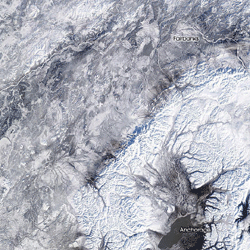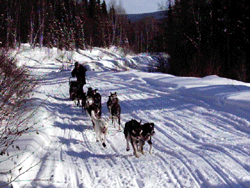Too Hot for the Trot
Air Date: Week of March 10, 2006

Lack of Snow Moves Iditarod North (Photo: NASA)
The Iditarod, the famous dog sled race through 1150 miles of Alaskan wilderness, has changed its course in recent years to make room for global warming. Host Bruce Gellerman talks with Stan Hooley, executive coordinator of the race.
Transcript
GELLERMAN: The Iditerad is called the last great race on earth.
[DOGS BARKING]
GELLERMAN: Each year since 1973, on the first Saturday in March, mushers have driven their dog sleds over more than a thousand desolate miles through some of the most grueling and gorgeous terrain Mother Nature has devised. This was what the start of this year’s race sounded like…
WOMAN: ten, nine, eight, seven, six, five, four, three, two, one, go! All right, down you huskies head on down the trail to Nome!
GELLERMAN: Down you huskies! The Iditerad trail – now a national historic trail – began as a mail and supply route running roughly along the Yukon River from Anchorage to Nome. But over the past decade race officials have had to alter the trail. Even in the middle of winter it’s been melting. Stan Hooley is Executive Director of the Iditerod race and I reached him in his office in Anchorage. Mr. Hooley, thanks for joining me.
HOOLEY: My pleasure.
GELLERMAN: What have the conditions been for this year’s running?
HOOLEY: Well, we’ve had some fresh snow. As a matter of fact, if I look outside race headquarters now we’re getting a light dusting here. Reports further up the trail is that there’s some fresh snow there as well. So what we thought might be problematic trail conditions, or less than desirable trail conditions a couple of weeks ago, Mother Nature seems to be solving that as we speak.
GELLERMAN: But now you’ve been altering the trail lately, as I understand.
HOOLEY: Well lately is kind of a relative term. It’s been warming for the last decade or more, and we’ve had to adapt things a little bit, sometimes shorten up day one, the day one start here in Anchorage. We did that again this year, but we’ve also done that I think eight out of the last 12 years, so it’s not new to us.

(Courtesy Iditarod Race Committee)
GELLERMAN: So it’s getting warmer?
HOOLEY: It is. I think globally this is, you know, a topic that is getting a lot of attention, a lot of discussion. And the realities we deal with is things are warmer than they used to be, and sometimes things aren’t quite as winter-like, at least in this area of the state, to stage this race. I would point out though we really probably have three or four distinctive climates, if you will, in this state over that thousand miles of trail. So the weather here will be much different than it is in the interior, and it will also be much different than that along the coast as we make our way to Nome.
GELLERMAN: Why do people do this?
HOOLEY: Well, it’s a lifestyle. I think those familiar with Alaska are familiar with the history of the traditional use of working sled dogs as a part of the culture. In fact, I would think that most folks would characterize this as a celebration of Alaska’s short-but-yet-storied past. It’s a state that’s relatively young compared to a lot of other states around the country, but the sport of mushing, the culture of mushing, is something that is very much at the core of the culture here.
GELLERMAN: Mr. Hooley, if I said, you know, Mush! On, you huskies! Is that kind of like the way it’s done?

(Takotna Community School)
GELLERMAN: Well Mr. Hooley, I gotta mush.
HOOLEY: Okay. Alright. We’ll let you do that, but thanks for your call.
GELLERMAN: Stan Hooley is Executive Director of the Iditerod race.
Links
Living on Earth wants to hear from you!
Living on Earth
62 Calef Highway, Suite 212
Lee, NH 03861
Telephone: 617-287-4121
E-mail: comments@loe.org
Newsletter [Click here]
Donate to Living on Earth!
Living on Earth is an independent media program and relies entirely on contributions from listeners and institutions supporting public service. Please donate now to preserve an independent environmental voice.
NewsletterLiving on Earth offers a weekly delivery of the show's rundown to your mailbox. Sign up for our newsletter today!
 Sailors For The Sea: Be the change you want to sea.
Sailors For The Sea: Be the change you want to sea.
 The Grantham Foundation for the Protection of the Environment: Committed to protecting and improving the health of the global environment.
The Grantham Foundation for the Protection of the Environment: Committed to protecting and improving the health of the global environment.
 Contribute to Living on Earth and receive, as our gift to you, an archival print of one of Mark Seth Lender's extraordinary wildlife photographs. Follow the link to see Mark's current collection of photographs.
Contribute to Living on Earth and receive, as our gift to you, an archival print of one of Mark Seth Lender's extraordinary wildlife photographs. Follow the link to see Mark's current collection of photographs.
 Buy a signed copy of Mark Seth Lender's book Smeagull the Seagull & support Living on Earth
Buy a signed copy of Mark Seth Lender's book Smeagull the Seagull & support Living on Earth

